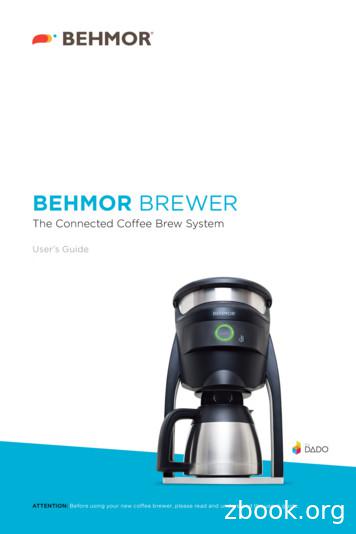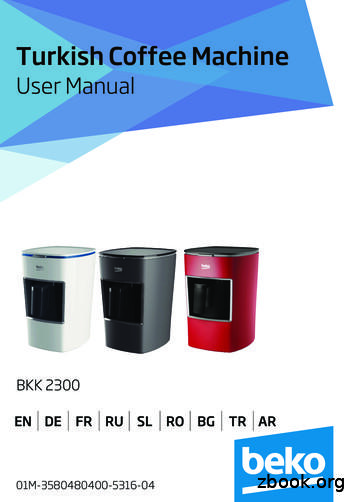Tanzania Coffee Annual Tanzania Coffee Annual Report
THIS REPORT CONTAINS ASSESSMENTS OF COMMODITY AND TRADE ISSUES MADE BYUSDA STAFF AND NOT NECESSARILY STATEMENTS OF OFFICIAL U.S. GOVERNMENTPOLICYRequired Report - public distributionDate: 5/23/2012GAIN Report Number:TanzaniaCoffee AnnualTanzania Coffee Annual ReportApproved By:Stephen HammondPrepared By:FAS/Nairobi StaffReport Highlights:Coffee importers from Japan followed by Europe and the United States continue to provide the bulk ofthe export demand for Tanzanian Arabica coffee producers. European importers top the list of Robustaimporters, buying more than 90 percent of Tanzania’s exportable surplus. Importers from those threedestinations will likely buy more than 90 percent of Tanzania’s roughly one million 60 kilogram bagsof exportable coffee surplus during marketing years (MY) 2012 and 2013.
Executive Summary:Japanese coffee importers buy about 50 percent of Tanzanian Arabica coffee bean exportable surplusand European importers buy almost 90 percent of Tanzania’s Robusta beans, while European and U.S.traders buy about 30 and 10 percent of the available Arabica beans, respectively. Reportedly, Europeancoffee traders source Tanzanian Robusta beans to blend with Kenyan AA coffee beans to obtain one ofthe African blends served in Europe.Reportedly, small amounts of Tanzanian Robusta coffee make their way into regional markets. As aresult of the East African Community (EAC) trade alliance, all products should trade freely across EACMember State borders. There remains an effort, however, to confine Tanzanian coffee production tosales at the Tanzania Coffee Auction.Buyers of AA Arabica coffee at the Nairobi, Kenya coffee exchange distinguish between Arabica coffeebeans produced on the foot hills of Mt. Kilimanjaro from Arabica beans produced on the foot hills ofMt. Kenya or Mt. Elgon. Reportedly, Tanzanian producers are improving the cupping quality of theirArabica production but equality may be some years away.The record-high Arabica bean prices will influence short and medium-term Tanzanian production andexportable surpluses, likely pushing 2013 (and beyond) exports to record levels. Reportedly, thedemand for new Arabica seedlings has been “astronomical” in Tanzania. The varieties have greaterdisease resistance, productivity and quality. Even though fertilizer and other input prices in Tanzaniaremain historically high, Tanzanian Arabica profit potential has encouraged growers to take the riskassociated with the new investments.For Tanzanian Robusta producers, prices peaked against Arabica prices in 2008/2009 reaching just over70 percent of Arabica values for a short period. The Robusta prices peaked at record levels at about thesame time Arabica bean values peaked but at a much lower 45 percent of Arabica values (please seeprice charts in the body of this report).This report reflects the analysis and opinions of the FAS/Nairobi Office of Agricultural Affairs and doesnot necessarily represent the views or opinions of the U.S. Department of Agriculture in Washington,D.C.
Production:FAS/Nairobi forecasts MY 2013 Arabica bean production at a record 700 thousand 60 kilogram bags(TKB), exceeding the MY 2009 record crop and Robusta production at a steady 300 TKB. Priceincentives will focus Tanzanian producer attention on quantity, even though current world prices havefallen below the record levels experienced during MYs 2011 and 2012.Tanzania Coffee--FAS/Nairobi20092010201120122013Beginning Stocks (1000 60 KG BAGS)Arabica Production (1000 60 KG BAGS)Robusta Production (1000 60 KG BAGS)Total Production (1000 60 KG BAGS)Total Supply (1000 60 KG BAGS)Bean Exports (1000 60 KG BAGS)Soluble Exports (1000 60 KG BAGS)Total Exports (1000 60 KG BAGS)Rst,Ground Dom. Consum (1000 60 KG BAGS)Soluble Dom. Cons. (1000 60 KG BAGS)Domestic Use (1000 60 KG BAGS)Ending Stocks (1000 60 KG BAGS)Total Distribution (1000 60 KG 1671,153*Revised TCB estimates—Otherwise FAS/Nairobi estimates and forecastsThe Tanzania Coffee Board (TCB) chose the British grading system based on bean size, shape anddensity. The grades in order of quality include: AA; A; B; PB; C; E; F; AF; TT; UG, and, TEX.Arabica coffee producers have found ideal coffee growing locations to Tanzania’s northern border withKenya and on its southern highlands, while coffee farmers around Lake Victoria produce the Robustabeans. Producers in the north of Tanzania produce coffee on the foot hills of Mts. Kilimanjaro andMeru, in the shade of banana trees. In both the north and southern highland, farmers harvest Arabicabeans between July and December. Around Lake Victoria, farmers harvest Robusta beans from Maythrough October.Coffee was first introduced to Tanzania in 1898 and now approximately 450,000 small-scale farmersproduce about 90 percent of Tanzania’s production. The remaining ten percent comes from 110 largescale farms, commonly known as estate farms. A reported two million Tanzanians work directly orindirectly in the coffee industry.Consumption:
The Japanese International Cooperation Agency estimates that Tanzanians drink roughly four percent ofdomestic production, more coffee per capita than any other east-Africans. The common method of localcoffee preparation differs considerably from European techniques. Tanzanians traditionally boil theground coffee beans to extract the coffee flavor. Anecdotally, in many of the major Tanzanian cities,coffee-shop owners have shifted away from traditional coffee preparation methods to European-stylecoffee-brewing techniques.Trade:The Tanzanian Coffee Board conducts coffee auctions in Moshi, Tanzania at the base of Mt.Kilimanjaro. Below, please find export data provided by the Tanzania Coffee Board.Tanzanian MY2011 Coffee Exports (60Kg Bags)ArabicaCountry60 Kg Bags /60 Kg%/ValueJapan322,339 318498,3054.8717%Russia17,08366,3883.892%South Africa10,62357,4085.402%Israel7,86035,5594.521%All Others20,03991,5794.573%Total643,051 2,998,1984.66100%Tanzanian MY2011 Coffee Exports (60Kg Bags)RobustaCountry60 Kg Bags /60 1.983%Israel1,2132,6572.190%USA5508471.540%All %Tanzanian MY2011 Coffee Exports (60Kg Bags)Total (includes Soluble GBE)Country60 Kg Bags /60 Kg%/USDEurope498,170 1,233,8562.4834%Japan332,067 8366,3883.892%South Africa10,62357,4085.402%Israel9,07338,2164.211%All Others39,825137,4243.454%Total1,009,709 3,646,8103.61100%Source: Tanzania Coffee BoardPolicy%/60 Kg Bags50%25%16%3%2%1%3%100%%/60 Kg Bags91%3%0%0%5%100%%/60 Kg Bags49%33%10%2%1%1%4%100%
The Government of Tanzania (GOT) established the Tanzania Coffee Board by means of the TanzaniaCoffee Industry Act No. 23 of 2001--amended in 2009. The TCB regulates the coffee industry, operatesthe coffee auction and advises growers and GOT officials on coffee growing, processing andmarketing. Other coffee-invested groups include the: Tanzania Coffee Research Institute; TanzaniaCoffee Association (Private Association of Coffee Traders); and, Tanganyika Coffee GrowersAssociation (Association of Coffee Estate growers).The TCB formulated and released a coffee-development strategy in 2010 that provides a vision of wherestakeholders would like to take Tanzanian coffee production. One of the most important goals will beto increase production by five thousand tons by 2016. To achieve the increase, coffee producers willneed to increase by 2,500 the hectares dedicated to coffee production and replace some 20 millionseedlings.PricesIn the Tanzania coffee export table above, the price differentials between Robusta and Arabica paid atauction are striking. On average during MY2011, Arabica yielded 4.66/60 Kg bag while Robustaaveraged just 1.75/60 Kg bag. The price data from the New York Coffee Market represented in thecharts here below corroborates the premium paid for Arabica coffee during the period of the exportsnoted above.Arabica vs. Robusta Coffee PricesArabica /60 KgRobusta40035030025020015010050Data Source: New York Market201220102008200620042002200019980
Robusta Coffee Prices as a percent of Arabica Coffee 2002200019980%Data Source: New York MarketArabica vs. Robusta Coffee Prices In Tanzanian Shillings (Tzs)ArabicaMillion Tzs/60KgRobusta12108642Data Sources: New York Market--Oanda Historical Ex Rate201220102008200620042002200019980
May 23, 2012 · coffee-shop owners have shifted away from traditional coffee preparation methods to European-style coffee-brewing techniques. Trade: The Tanzanian Coffee Board conducts coffee auctions in Moshi, Tanzania at the base of Mt. Kilimanjaro. Below, please find export data provided by the Tanzania Coffee Board. Tan
TANZANIA COFFEE INDUSTRY VALUE CHAIN ANALYSIS 2 Table A: Tanzania Coffee Production 1999/2000-2007/08 Coffee Season Production in Metric Tons Source: Tanzania Coffee Board Since the mid-1990s, the country's coffee industry has been in a state of stagnation or decline. Coffee production moderately declined from the early 1990s to 1998 after .
TARP Tanzania Agricultural Research Project TAWIRI Tanzania Wildlife Research Institute TAWLAE Tanzania Association of Women Leaders in Agriculture and Environment TBC Tanzania Broadcasting Cooperation TBS Tanzania Bureau of Standard TCC Tanzania Communications Commission TCCIA Tanzan
Coffee: The quality of the coffee and water used is directly related to the quality of the coffee brewed. We highly recommend using freshly ground coffee or commercially packed coffee that is sealed for freshness. The proper amount of ground coffee and water is critical to the finished brew. A ratio of 2 Tablespoons of coffee for every 6 oz. of .
drink coffee, coffee samples based on each of the following six brewing methods were analysed: Filter coffee brewed coffee maker, French press coffee, boiling coffee, coffee brewed in mocha pot, home-brewed espresso and espresso from cafes. The water used f
Dr. Gerson, Dr. Kelley, Dr. Gonzales, And Others 2. Coffee, A Remarkable Herb What Is Coffee? Growing And Processing Of Coffee The Best Coffee For Coffee Enemas Coffee As A Beverage 3. Effects Of Coffee Enemas Eff
Short Coffee 3 oz (90 ml) Coffee 9 oz (270 ml) Long Coffee 12 oz (360 ml) MY COFFEE The My Coffee setting allows the user to select any volume between 1 oz and 7 oz. 1 Press multiple times until "MY COFFEE" is displayed. 2 Press and hold until "MY COFFEE—PROGRAM QUANTITY" is displayed, then release. 3 Once the desired amount is .
Coffee Machine / User Manual 5 / 147 EN Do not start to cook coffee without putting water into the coffee pot. Do not put any substances apart from coffee, sugar and water into the coffee pot. Do not drink the cooked coffee using the coffee pot. Due to the manufacturing technology, steam and odour may arise at the heating element of your .
2 Annual Book of ASTM Standards, Vol 01.06. 3 Annual Book of ASTM Standards, Vol 01.01. 4 Annual Book of ASTM Standards, Vol 15.08. 5 Annual Book of ASTM Standards, Vol 03.02. 6 Annual Book of ASTM Standards, Vol 02.05. 7 Annual Book of ASTM Standards, Vol 01.08. 8 Available from Standardization Documents Order Desk, Bldg. 4 Section D, 700 Robbins Ave., Philadelphia, PA 19111-5094, Attn: NPODS .























